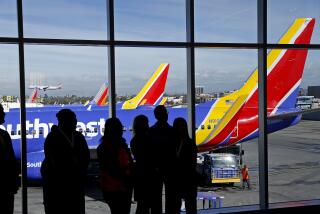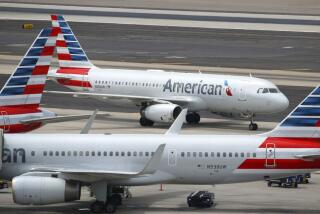Pilot’s Mistaken Push Puts Jet Into Dive : Safety: 17 injured on American Airlines flight when the reserve officer tried to find room for a box of beverages. Stricter seat belt rule urged.
- Share via
WASHINGTON — An American Airlines pilot searching for a place to put a box of soft drinks and coffee began a trail of errors that sent a jumbo jet into a dive over Jamaica, injuring 17 passengers and crew, federal safety officials said Friday.
The incident gave new impetus to proposals that passengers be required to keep their seat belts fastened at all times. The most seriously injured passenger, who underwent surgery for a ruptured spleen, was seated but did not have the belt fastened. He apparently hit the ceiling during the violent maneuver.
American Flight 901, a McDonnell Douglas MD-11 carrying 80 passengers, was on its way to Buenos Aires from Miami shortly before 1 a.m. Wednesday when it suddenly went into a three-second dive followed by a 16-second bumpy recovery, a spokesman for the National Transportation Safety Board said.
The airline at first thought the plane had hit severe turbulence. But when safety board and airline investigators interviewed the crew, a different story emerged.
According to the safety board and Robert Baker, executive vice president-operations for American, the plane was being flown by a reserve first officer while the captain was on a break. The regular first officer remained seated on the right side of the cockpit. On long flights, such planes typically have three crew members so each can take breaks.
At 12:54 a.m., about 80 minutes into the flight, a flight attendant brought a box of soft drinks, coffee and water to the cockpit. Baker said this normally is done at the beginning of the flight so attendants do not have to enter the cockpit repeatedly.
Baker said crews have found that the only stable spot to place the beverage box is on the footrest of the jump seat behind the first officer. However, the first officer’s seat was too far back for it to fit.
Trying to be helpful, the reserve first officer reached over to the first officer’s seat latch to move the seat forward. The seat moved forward, apparently startling the first officer, whose legs were crossed, and pushing him into the control column.
The MD-11 autopilot, which was engaged at the time, is designed to turn itself off if the control column is moved manually and held out of position for three seconds. With the column pushed forward and the autopilot off, the plane abruptly nosed down.
Food was being served at the time, and much of it was plastered on the ceiling. A number of passengers and crew members were thrown about, most of them in the rear of the plane.
The cockpit crew had a “good recovery” at that point, a board spokesman said, stabilizing the plane within about 16 seconds. The plane then returned to Miami.
“They’re pretty shook up over the whole thing,” Baker said. “They did a good job after the incident.”
The incident came during discussions at the Transportation Department about whether the Federal Aviation Administration should issue a rule requiring passengers to keep their seat belts on at all times while seated, department sources said. Airlines now make public announcements recommending the practice, but it is not required when the seat belt light is off.
Officials said the wife of the seriously injured passenger was seated next to him, had kept her belt on and was not injured, providing an example of the effectiveness of seat belts.
Baker said he would like to see a federal rule on seat belts. He said American captains are told to be “as stern as they choose to be” in cautioning passengers to wear their seat belts.
More to Read
Sign up for Essential California
The most important California stories and recommendations in your inbox every morning.
You may occasionally receive promotional content from the Los Angeles Times.










